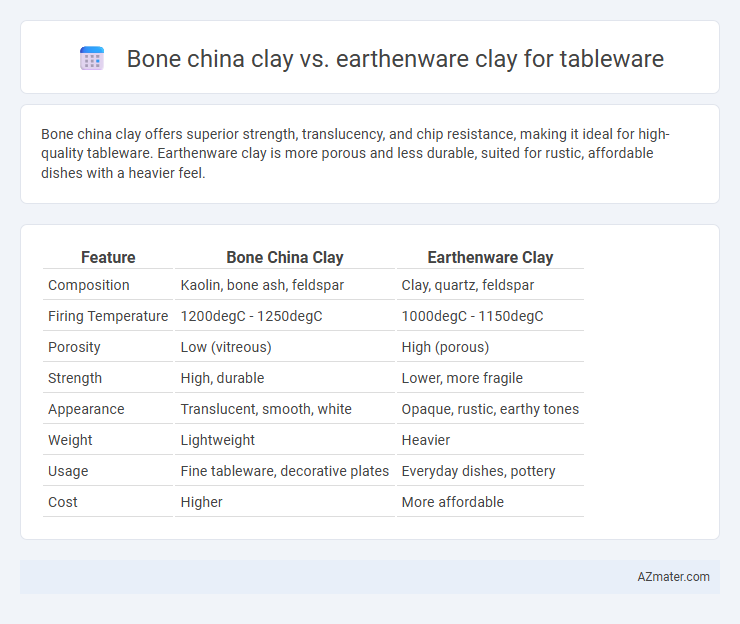Bone china clay offers superior strength, translucency, and chip resistance, making it ideal for high-quality tableware. Earthenware clay is more porous and less durable, suited for rustic, affordable dishes with a heavier feel.
Table of Comparison
| Feature | Bone China Clay | Earthenware Clay |
|---|---|---|
| Composition | Kaolin, bone ash, feldspar | Clay, quartz, feldspar |
| Firing Temperature | 1200degC - 1250degC | 1000degC - 1150degC |
| Porosity | Low (vitreous) | High (porous) |
| Strength | High, durable | Lower, more fragile |
| Appearance | Translucent, smooth, white | Opaque, rustic, earthy tones |
| Weight | Lightweight | Heavier |
| Usage | Fine tableware, decorative plates | Everyday dishes, pottery |
| Cost | Higher | More affordable |
Introduction to Bone China Clay and Earthenware Clay
Bone china clay is a refined porcelain material made from a blend of bone ash, feldspathic material, and kaolin, renowned for its high strength, translucency, and whiteness, making it ideal for delicate tableware. Earthenware clay consists primarily of natural, porous clay fired at lower temperatures, resulting in a more porous and less durable ceramic suitable for casual or decorative tableware. Differences in composition and firing temperature influence the durability, appearance, and functionality of tableware produced from these two clay types.
Composition and Raw Materials
Bone china clay consists primarily of kaolin, feldspar, and calcined animal bone ash, which gives it exceptional translucency, whiteness, and strength. Earthenware clay is composed mainly of natural clays with iron and other impurities, resulting in a porous and more opaque finished product that fires at lower temperatures. The high calcium phosphate content in bone china enhances durability and chip resistance, while earthenware's raw materials make it more porous and less durable but easier to work with and less expensive.
Firing Temperature and Process
Bone china clay requires a high firing temperature between 1200degC to 1250degC, resulting in a translucent, strong, and vitrified tableware with a smooth finish. Earthenware clay fires at a lower temperature, around 1000degC to 1150degC, producing porous and less durable tableware that often needs glazing to achieve waterproof qualities. The firing process for bone china involves a controlled, high-temperature kiln cycle to develop its characteristic whiteness and strength, while earthenware undergoes a simpler, lower-temperature firing that retains a rustic texture.
Durability and Strength Comparison
Bone china clay exhibits superior durability and strength compared to earthenware clay, primarily due to its high-fired vitrification process and the presence of bone ash, which enhances its toughness and chip resistance. Earthenware clay, fired at lower temperatures, remains more porous and fragile, making it prone to cracks and chipping under regular use as tableware. The higher mechanical strength and reduced water absorption of bone china make it the preferred choice for long-lasting, resilient tableware in both domestic and commercial settings.
Porosity and Water Absorption
Bone china clay exhibits lower porosity and water absorption compared to earthenware clay, resulting in a denser and more durable tableware surface. Earthenware clay typically has higher porosity, making it more absorbent and less suitable for holding liquids without glazing. This difference significantly affects the functionality and longevity of tableware, with bone china offering superior resistance to water damage and staining.
Aesthetic Appeal: Color and Translucency
Bone china clay offers a superior aesthetic appeal for tableware with its delicate translucency and pure white color, allowing light to pass through and creating an elegant, refined appearance. Earthenware clay, on the other hand, exhibits a more opaque finish with earthy tones, providing a rustic and warm look but lacking the brightness and translucency of bone china. The color and translucency differences significantly influence the visual sophistication and style of the final tableware pieces.
Suitability for Tableware Use
Bone china clay offers exceptional strength, translucency, and chip resistance, making it highly suitable for elegant tableware that requires durability and a refined appearance. Earthenware clay, while more porous and less durable, is favored for rustic or casual table settings due to its warm, earthy aesthetic and affordability. The choice between bone china and earthenware clay depends on the desired balance between durability, appearance, and cost in tableware production.
Design Versatility and Decoration Options
Bone china clay offers superior design versatility and decoration options for tableware due to its fine, smooth texture and translucency, allowing intricate detailing and vibrant glazing. Earthenware clay, while more porous and less refined, supports a range of rustic and earthy finishes, suitable for hand-painted or textured decoration but lacks the delicate precision achievable in bone china. Both clays accommodate various artistic techniques, yet bone china's strength and translucency enable more sophisticated and durable decorative effects.
Maintenance and Care Differences
Bone china clay offers superior durability and resistance to chipping compared to earthenware clay, making it easier to maintain with regular dishwasher use and mild detergents. Earthenware clay is more porous and prone to cracking, requiring gentle hand washing and avoiding sudden temperature changes to prevent damage. Bone china's non-porous surface also resists staining and odors, while earthenware needs more frequent seasoning or sealing to preserve its appearance.
Environmental Impact and Sustainability
Bone china clay offers superior durability and a thinner, lighter finish with lower firing temperatures compared to earthenware clay, making it more energy-efficient during production. Earthenware clay typically requires higher firing temperatures and results in a heavier, more porous product, which can increase energy consumption and reduce longevity, impacting sustainability. The sourcing of bone china clay relies on calcined animal bone ash, raising ethical considerations, whereas earthenware clay is entirely mineral-based and often more abundant and locally sourced, influencing its environmental footprint.

Infographic: Bone china clay vs Earthenware clay for Tableware
 azmater.com
azmater.com